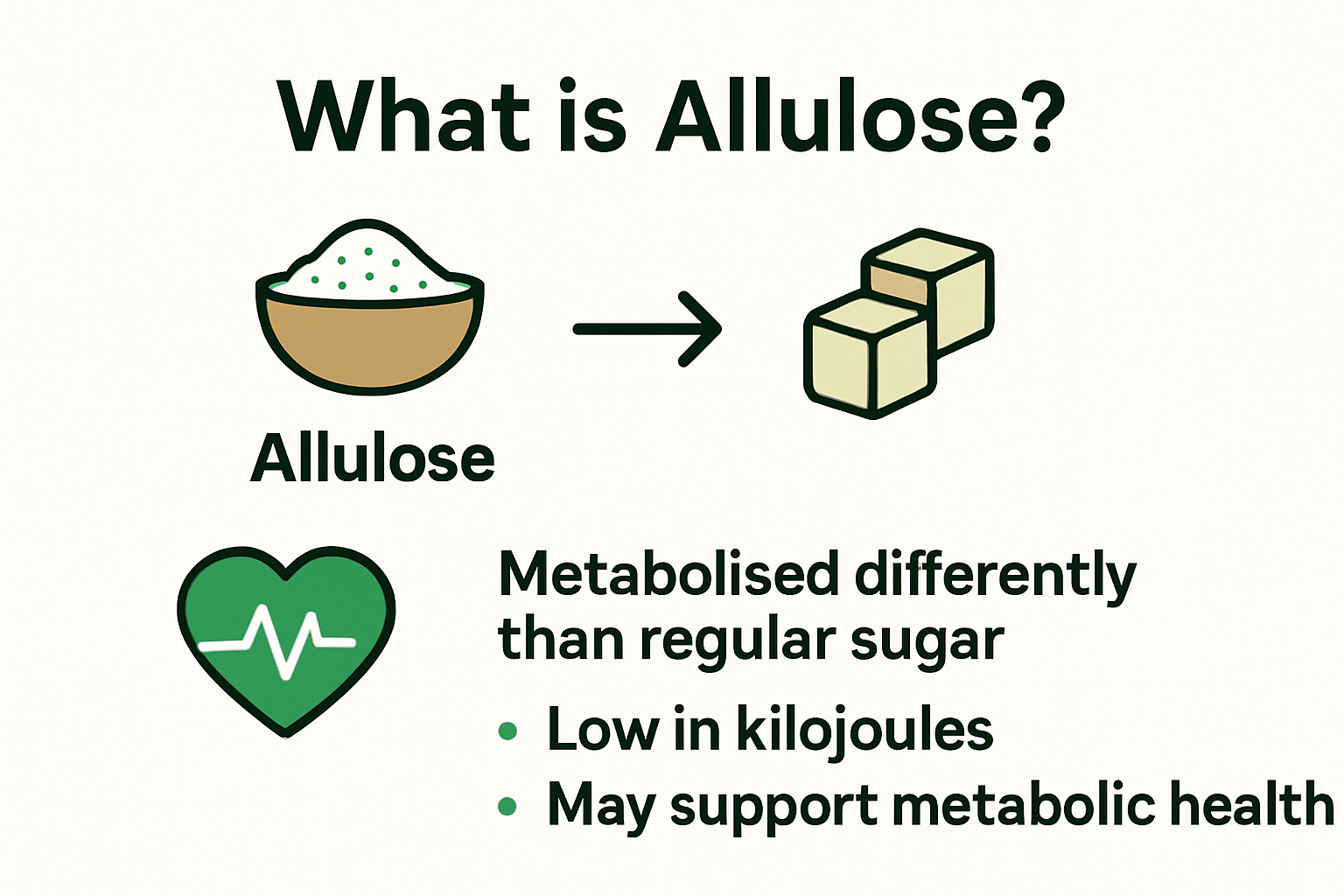
Healthy desserts have long felt out of reach for anyone watching their sugar intake in South Africa. Turns out, the sweetener allulose delivers about 70 percent of sugar’s sweetness with almost no calories. Most people expect sugar alternatives to taste a bit weird or ruin a good milk tart. The real surprise is that new recipes are showing allulose works so well you can bake cupcakes, mousses, and kid-friendly treats that taste just as lekker as the originals, without messing up your health.
Table of Contents
- What Is Allulose And Why Choose It?
- Delicious Allulose Dessert Recipes To Try
- Benefits For Keto, Diabetic, And Vegan Lifestyles
- Tips For Baking With Allulose In South Africa
Quick Summary
| Takeaway | Explanation |
|---|---|
| Allulose as a Healthy Sweetener | Allulose is a natural sweetener that provides about 70% of traditional sugar’s sweetness with significantly lower calories, making it ideal for health-conscious individuals. |
| Metabolic Benefits for Diabetics | Research shows that allulose does not raise blood glucose or insulin levels, making it an effective ingredient for those managing diabetes and seeking stable blood sugar control. |
| Versatile in Baking | Allulose can replace traditional sugars in recipes, providing similar textures and flavors while requiring slight modifications in baking techniques, such as reduced temperatures and adjusted sweetness levels. |
| Dietary Compatibility | Allulose is suitable for various dietary lifestyles, including keto, diabetic, and vegan, supporting diverse nutritional goals without sacrificing flavor or enjoyment. |
| Practical Baking Tips | South African bakers should adjust recipes by using 1.3 times the amount of allulose compared to regular sugar and adapt for local humidity and altitude to achieve optimal results. |
What Is Allulose and Why Choose It?
The Scientific Profile of Allulose
Allulose is a rare sugar molecule scientifically classified as a monosaccharide that naturally occurs in small quantities within select foods like figs, raisins, and wheat. According to Healthline, this unique sugar provides approximately 70% of traditional sugar’s sweetness while delivering only 0.2 to 0.4 calories per gram - a remarkable nutritional profile for those monitoring caloric intake.
What distinguishes allulose from conventional sugars is its metabolic behaviour. Research published in PubMed demonstrates that consuming 5 to 10 grams of allulose with a meal can significantly reduce postprandial blood glucose levels. This characteristic makes it particularly attractive for individuals managing diabetes or seeking stable blood sugar control.

Health Benefits and Metabolic Advantages
Allulose presents a compelling array of health benefits that extend beyond mere sweetness. Research indicates that this remarkable sugar does not raise blood glucose or insulin levels, positioning it as an exceptional alternative for health-conscious consumers. Its unique metabolic pathway means the body processes allulose differently from traditional sugars, effectively passing through without being fully metabolised.
For individuals following specific dietary approaches like keto or low-carb regimens, allulose offers an intelligent sugar alternative. Its minimal caloric impact and negligible effect on blood sugar make it an ideal ingredient for those seeking to maintain metabolic flexibility while enjoying sweet flavours.
Moreover, allulose demonstrates potential advantages beyond blood sugar management. Preliminary studies suggest it might support weight management efforts and provide antioxidant properties, though more comprehensive research is needed to fully understand its comprehensive health implications.
The molecular structure of allulose allows it to behave similarly to sugar in culinary applications, providing sweetness and functional properties without the metabolic drawbacks associated with traditional refined sugars. Whether you are crafting delicate pastries, experimenting with dessert recipes, or simply seeking a healthier sweetening option, allulose represents a sophisticated and scientifically backed solution for modern nutritional needs.
For those curious about the precise nutritional landscape of this innovative sweetener, our comprehensive calorie guide offers in-depth insights into its remarkable properties and potential applications.
Delicious Allulose Dessert Recipes to Try
Exploring allulose dessert recipes opens up a world of delectable treats that satisfy sweet cravings while maintaining nutritional integrity. These recipes demonstrate how this innovative sweetener transforms traditional desserts into healthier culinary experiences.
Baking Innovations with Allulose

Baking with allulose requires understanding its unique properties. Research published in Food Science and Technology reveals that allulose can produce remarkable results in confectionery applications. When substituting traditional sugar, bakers can achieve comparable texture and sweetness with significantly reduced caloric impact.
A fascinating study in LWT - Food Science and Technology demonstrated that replacing sucrose with D-allulose in sponge cake formulations generates distinctive aroma profiles. The research highlighted increased generation of furans and pyrazines, suggesting allulose not only reduces calories but potentially enhances flavor complexity.
For those seeking simple and healthy sweet recipe options, allulose offers extraordinary versatility. From chocolate mousses to fruit tarts, this sweetener adapts beautifully across various dessert styles.
Classic Desserts Reimagined
Traditional desserts receive a nutritional upgrade when allulose enters the recipe. Consider classic chocolate cupcakes. Research indicates that D-allulose cupcakes achieve comparable textural properties to sucrose versions, particularly when baked for slightly longer durations. This means home bakers can create guilt-free versions of beloved treats without compromising taste or texture.
Chocolate lovers will appreciate that scientific studies suggest D-allulose chocolate can positively influence metabolic processes. For health-conscious individuals following specific dietary approaches, these reimagined desserts represent more than just a sweet indulgence - they’re a strategic nutritional choice.
The versatility extends to kid-friendly recipes as well. Imagine creating ice creams, puddings, and cookies that deliver delightful flavors while supporting balanced nutrition. Allulose enables parents to introduce sweet treats that don’t compromise children’s health.
Key recipe considerations when working with allulose include understanding its slightly different baking characteristics. Unlike traditional sugar, allulose requires slight recipe modifications to achieve optimal results. Reduced browning times, potential moisture adjustments, and precise measurement become crucial for creating perfect desserts.
Whether you’re crafting delicate pastries, rich chocolate delights, or refreshing frozen treats, allulose provides a sophisticated solution for health-conscious sweet enthusiasts. These recipes prove that nutritional mindfulness and culinary creativity can coexist beautifully, transforming dessert from a guilty pleasure into a smart, enjoyable experience.
To help you compare how allulose transforms classic desserts versus traditional sugar, here’s a summary of key baking differences and outcomes:
| Dessert Type | With Traditional Sugar | With Allulose |
|---|---|---|
| Chocolate Cupcakes | Standard sweetness, higher calories, regular browning | 70% sweetness, lower calories, requires slightly longer baking, needs moisture adjustment |
| Sponge Cakes | Usual aroma, higher calories, normal browning | Enhanced aroma (more furans/pyrazines), fewer calories, increased browning, adjust baking temp |
| Chocolate Mousse | Requires more sugar for sweetness, higher caloric load | Similar sweetness achieved with less calories, softer texture, adjust sweetener ratio |
| Kid-Friendly Cookies | Traditional taste, high sugar | Nearly same taste, less sugar, may require shorter baking time |
Benefits for Keto, Diabetic, and Vegan Lifestyles
Allulose emerges as a nutritional powerhouse that transcends traditional dietary boundaries, offering remarkable benefits for individuals following keto, diabetic, and vegan lifestyles. This innovative sweetener represents more than just a sugar substitute - it’s a strategic nutritional tool designed to support diverse health goals.
Metabolic Management for Diabetic Individuals
For individuals managing diabetes, allulose presents a scientifically promising solution. Research published in the National Institutes of Health demonstrates that allulose can inhibit α-glucosidase activities, effectively suppressing glycemic responses after carbohydrate consumption. This mechanism suggests significant potential for blood sugar regulation.
Furthermore, studies on animal models reveal compelling metabolic benefits. Research indicates that allulose consumption can reduce body weight gain and improve insulin resistance in diet-induced obese and type 2 diabetic models. In C57BL/KsJ-db/db mice, allulose supplementation demonstrated remarkable effects, including lowered blood glucose levels, enhanced hepatic glucokinase activity, and reduced hepatic triglyceride and free fatty acid levels.
Those seeking comprehensive diabetic-friendly nutritional strategies will find allulose an invaluable addition to their dietary toolkit. Its ability to stimulate glucagon-like peptide-1 (GLP-1) release further supports glucose concentration regulation, offering a multifaceted approach to metabolic health.
Below is a table summarising how allulose specifically supports three popular dietary lifestyles discussed in this guide:
| Lifestyle | Allulose Benefit | Key Outcome |
|---|---|---|
| Diabetic | Does not raise blood glucose or insulin; suppresses glycemic response | Blood sugar regulation, safe sweetening |
| Keto/Low-Carb | Negligible impact on blood sugar; minimal calories | Maintains ketosis, fits low-carb diets |
| Vegan | Plant-derived, contains no animal products | Vegan-friendly, natural sweetness |
Keto and Low-Carb Dietary Compatibility
Keto and low-carb dieters require precise nutritional choices, and allulose delivers exceptional compatibility. With its negligible impact on blood sugar and minimal caloric contribution, allulose perfectly aligns with ketogenic principles. Unlike traditional sugars that can disrupt ketosis, allulose provides sweetness without metabolic interference.
The molecular structure of allulose means it passes through the body largely unmetabolised, making it an ideal sugar alternative for those strictly monitoring carbohydrate intake. Its ability to provide sweetness without compromising dietary goals makes it a strategic ingredient for individuals committed to low-carb nutritional approaches.
Vegan and Plant-Based Lifestyle Considerations
Vegan nutritional strategies demand innovative, plant-derived alternatives, and allulose meets these requirements brilliantly. Derived from natural sources like wheat and figs, allulose offers a completely plant-based sweetening solution that aligns seamlessly with vegan dietary principles.
Beyond its plant origins, allulose provides nutritional advantages that extend beyond traditional sweeteners. Its minimal caloric profile, combined with potential metabolic benefits, makes it an attractive option for health-conscious vegans seeking nuanced nutritional approaches.
The versatility of allulose means individuals across dietary spectrums - whether managing diabetes, following ketogenic protocols, or embracing plant-based lifestyles - can enjoy sweet experiences without compromising their nutritional objectives. Its scientific backing and adaptable nature position allulose as a revolutionary ingredient in modern, health-focused nutrition.
By offering a sophisticated alternative to traditional sugars, allulose demonstrates that dietary restrictions need not mean sacrificing flavor or enjoyment. Instead, it represents a sophisticated approach to nutrition that prioritizes both health and culinary pleasure.
Tips for Baking with Allulose in South Africa
Mastering allulose baking requires understanding its unique molecular characteristics and adapting traditional baking techniques to harness its remarkable potential. South African home bakers and culinary enthusiasts can transform their sweet creations by embracing these specialized allulose baking strategies.
Understanding Allulose Baking Fundamentals
Bakerpedia research reveals critical insights for successful allulose baking. Unlike traditional sugar, allulose presents distinctive chemical properties that demand nuanced approach. Notably, allulose is approximately 70% as sweet as sugar, which means bakers must adjust quantities to achieve desired sweetness levels.
When substituting sugar, use approximately 1.3 times the amount of allulose to match traditional sweetness profiles. This ratio ensures your baked goods maintain the delectable flavour profile South African palates appreciate. Comprehensive cooking guides recommend starting with smaller substitution percentages and gradually increasing as you become comfortable with its unique properties.
Advanced Baking Techniques and Modifications
Temperature management becomes crucial when working with allulose. Bakerpedia experts recommend reducing oven temperatures by approximately 25°F (14°C) to prevent over-browning. This adjustment compensates for allulose’s rapid participation in Maillard reactions, which can cause faster caramelization compared to traditional sugars.
Interestingly, allulose does not interact with yeast like conventional sugars. This means bakers must be cautious when creating bread recipes, as allulose cannot serve as a food source for yeast fermentation. For bread and other yeasted products, consider hybrid approaches that combine allulose with small quantities of traditional sugars to support yeast activation.
Practical Considerations for South African Bakers
Local environmental factors like humidity and altitude can further influence allulose baking results. South African kitchens - ranging from coastal Cape Town to high-altitude Johannesburg - might require slight recipe modifications. Moisture content becomes particularly important, as allulose can behave differently from sugar in various baking contexts.
When preparing desserts like malva pudding or milk tart, traditional South African favorites, start by replacing only a portion of sugar with allulose. This gradual approach allows bakers to understand how the sweetener interacts with local ingredients and cooking styles. Experiment with small batches, making incremental adjustments to achieve the perfect texture and sweetness.
Kid-friendly recipe adaptations offer exciting opportunities for families seeking healthier dessert options. By understanding allulose’s unique properties, South African parents can create nutritious treats that don’t compromise on taste or enjoyment.
Consider keeping a detailed baking journal to track your allulose experiments. Note temperature adjustments, sweetness ratios, and ingredient interactions. This methodical approach will help you develop a personalized understanding of how allulose performs in your specific kitchen environment.
Below is a quick-reference table summarising top baking modifications and adjustment tips for using allulose in South African kitchens:
| Baking Aspect | Sugar Approach | Allulose Adjustment |
|---|---|---|
| Sweetener Substitution | 1:1 sugar ratio | Use 1.3x allulose for similar sweetness |
| Baking Temperature | Standard recipe temperature | Reduce by approx. 25°F (14°C) to prevent over-browning |
| Fermentation with Yeast | Sugar feeds yeast for rising | Combine allulose with some sugar to activate yeast |
| Browning/Caramelisation | Normal rate | Faster browning; bake for shorter time or lower temp |
| Moisture Content | Regular recipe | Monitor and adjust moisture as allulose can change texture |
| Altitude/Humidity | Standard method | Adjust based on local environmental conditions |
Ultimately, baking with allulose is a journey of culinary exploration. Each recipe presents an opportunity to reimagine traditional sweets through a lens of health-conscious innovation. With patience, practice, and a willingness to experiment, South African bakers can master this revolutionary sweetener, creating desserts that are both delicious and nutritionally sophisticated.
Frequently Asked Questions
What is allulose and how is it different from regular sugar?
Allulose is a rare sugar that offers about 70% of the sweetness of traditional sugar while delivering almost no calories. Unlike regular sugar, allulose does not spike blood glucose or insulin levels, making it a healthier alternative for those monitoring their sugar intake.
Can allulose be used in baking recipes?
Yes, allulose can be substituted for traditional sugars in baking recipes. However, you’ll need to use approximately 1.3 times the amount of allulose to achieve a similar level of sweetness. Also, consider reducing baking temperatures to prevent over-browning.
Are allulose desserts suitable for individuals with diabetes?
Absolutely. Allulose does not raise blood glucose or insulin levels, making it a suitable sweetener for people with diabetes. It can help manage blood sugar levels while still allowing for sweet treats.
Can I use allulose in vegan dessert recipes?
Yes, allulose is plant-derived and can be incorporated into various vegan dessert recipes. It offers a sweet option without the calories of traditional sugars, making it an excellent choice for health-conscious vegans.
Experience Guilt-Free Sweetness With Allulo’s Allulose Range
If you dream of enjoying classic desserts like cupcakes, milk tart, and cookies without worrying about sugar spikes or empty calories, you are not alone. This article highlighted a very real challenge: finding a natural sweetener that matches both the flavour and baking results of sugar, especially for keto, diabetic, and health-focused lifestyles. With allulose, you get the sweet taste you love with the peace of mind your family deserves. Discover the possibilities in our Allulose Collection – your go-to source for organic, pure allulose, designed for modern South African kitchens.

Give your favourite recipes a healthy twist today. Browse our wide selection at https://allulo.co.za and choose the allulose product that fits your style. Level up your desserts now with a sweetener trusted by health authorities, families, and food lovers across South Africa. Don’t let another meal pass you by – shop Allulo’s allulose and embrace real sweetness with confidence.
Recommended
- 10 Kid Friendly Allulose Recipes for Healthy Sweet Treats 2025 - Allulo
- Allulose Recipes Easy: Healthy & Guilt-Free Sweets for 2025 - Allulo
- Can You Cook With Allulose? Safe Sweetening for 2025 - Allulo
- Allulose for Low-Carb Diets: A Smart Sugar Alternative 2025 - Allulo
- Allulose Calorie Content Guide 2025: Healthy Sugar Alternative - Allulo
- What Foods Contain Allulose? Guide for Health-Conscious South Africans 2025 - Allulo


